“Once on the Moon, on the lunar surface in the dress, in the life support system, you couldn’t see the camera. They couldn’t bend their head that far down to see the scale … They had no viewfinder – they had to aim by moving their body.” – Jan Lundberg, chief designer of the Hasselblad cameras allegedly used by the Apollo astronauts
“They had to effectively guess where they were pointing the camera.” – HJP Arnold, the Kodak executive who supplied the Ektachrome film for the missions
The issue that most of the Moon hoax and ‘debunking’ sites spend the most time on, by far, is the photographic anomalies. And that, I suppose, is to be expected, since with the original videotapes, telemetry tapes and blueprints all having conveniently disappeared, and with most of the Moon rocks missing and their legitimacy being unverifiable, there isn’t much else in the way of physical evidence to examine.
Skeptics have identified a number of problems with NASA’s official photographs of the alleged Moon landings, including; flags appearing to wave despite the lack of atmosphere; non-parallel shadows, suggesting multiple light sources; objects in the shadows that are clearly visible when they shouldn’t be, again indicating multiple light sources; the complete lack of stars in the lunar sky; identical backgrounds in photos that NASA has claimed were shot at different locations; and inconsistencies with the crosshair reference marks.
We will look at each of these in some detail – well, actually we will look at most of them in some detail. Because as it turns out – and I know that this will come as a huge disappointment to all the ‘debunkers’ – I don’t really give a shit whether the flag is waving or not. Many of the ‘debunking’ websites devote an inordinate amount of time to the issue, as though it were the primary plank on which the ‘conspiracy theories’ rested. They do this because the videos and photos are ambiguous and open to interpretation, and the ‘debunkers’ realize that people are going to see in them what they want to see.
The truth though is that it does not matter in the least whether the flag is waving. That is just one tiny drop of potential evidence in an overflowing bucket.
Some of the other problems with the images are considerably less ambiguous. But before we even get to those, we must first discuss the fact that the very existence of the photographs is a technical impossibility. Simply stated, it would not have been possible to capture any of the images allegedly shot on the Moon in the manner that NASA says they were captured.
Back in the day, you see (and younger readers may again want to cover their eyes), cameras weren’t all that smart, so everything had to be done manually. The photographer had to manually focus each shot by peering through the viewfinder and rotating the lens until the scene came into focus. The proper aperture and shutter speeds had to be manually selected for each shot as well, to insure a proper exposure. That required peering through the viewfinder as well, to meter the shot. Finally, each shot had to be properly composed and framed, which obviously also required looking through the viewfinder.
The problem for the astronauts is that the cameras were mounted to their chests, which made it impossible to see through the viewfinder to meter, frame and focus the shots. Everything, therefore, was pretty much of a guess. Focusing would have been entirely guesswork, as would the framing of each shot. An experienced photographer can accurately estimate the exposure settings, but the astronauts lacked such experience and they were also handicapped by the fact that they were viewing the scenes through heavily tinted visors, which meant that what they were seeing was not what the camera was seeing.
To add to their troubles, they were wearing space helmets that seriously restricted their field of vision, along with enormously bulky, pressurized gloves that severely limited their manual dexterity. The odds then of getting even one of the three elements (exposure, focus and framing) correct under those conditions on any given shot would have been exceedingly low. And yet, amazingly enough, on the overwhelming majority of the photos, they got all three right!
A rather self-important gent by the name of Jay Windley, one of the most prominent of the NASA-approved ‘debunkers,’ attempts to spin all this away on his website, www.clavius.org. According to Windley, “The exposures were worked out ahead of time based on experimentation. The ASA/ISO rating of the film was known, and NASA photographers precomputed the necessary exposures … In many cases the camera settings for planned photos were given in the astronauts’ cuff checklists.”
No shit, Jay? Did they send an advance team to the Moon to do that “experimentation”? Because the lighting conditions on the Moon are pretty unique, as you well know, and nobody had ever been there before, so I’m not really seeing how NASA’s photographers were able to work the exposures out “ahead of time.” And what “planned photos” are you referring to? How did they know what they were going to photograph before they even knew what was there? They knew they were going to take photos of each other, I suppose, and of the flag and lander, but they would have had no clue how those things were going to be lit, and it’s the lighting, not the subject, that primarily determines the exposure settings.
Windley of course knows that, since he claims on his site that he is “an experienced photographer [who] has worked professionally in that area from time to time.” He must also know then that his comments about the unimportance of properly focusing a shot are intentionally misleading. He starts off on the right track, more or less, advising readers that an increased depth of field “means that when the lens is set to focus at a certain distance, objects somewhat nearer and farther from this ideal distance are also sharply focused. The narrower the aperture, the greater the depth of field.”
It is certainly true that the smaller the aperture, the greater the depth of field will be. And the greater the depth of field, the more of the background and foreground will be in focus, assuming that the subject is in proper focus. Windley, like the rest of the ‘debunkers,’ would like us to believe that all of the photos shot on the lunar surface were shot with a very small aperture setting (which supposedly explains the lack of stars in the lunar sky, but we’ll get to that soon enough), which would maximize the depth of field. And the greater the depth of field, according to Windley, “the sloppier the photographer can be about his focus settings.”
That last statement, for those who may have missed it, is the part that isn’t actually true. An increased depth of field most certainly does not mean that you can use the ‘close enough’ technique to focus your camera. Depth of field has nothing to do with whether your subject is sharply focused or not. If your subject is sharply focused, then depth of field determines how many of the other objects in the background and foreground of your photo will be in focus as well. If your subject is not sharply focused, however, then your photo is going to suck regardless of the amount of depth of field.
As for framing the shots, Windley claims that mostly wide-angle lenses were used, which meant that, “It was sufficient to point the camera in the general direction of the subject and you would be likely to frame it well enough.” So apparently all the fuss about framing, exposure and focus is much ado about nothing. All you need do is write the exposure settings down on your sleeve, ballpark the focus, and point your camera in “the general direction of the subject” and you’ll get great shots nearly every time!
Windley then adds (and this is my favorite part of his photography tutorial) that on the later missions, “a 500mm telephoto lens was also taken, and the cameras were modified with sighting rings to help aim them. Normally the camera would be mounted on the space suit chest bracket, but for telephoto use the astronaut would have to remove it and hold it at eye level in order to sight down the rings.”
As any photographer knows, getting a decent shot with a 500mm lens without the use of a tripod is a pretty tall order, even for a seasoned professional. Getting a decent hand-held shot with a 500mm lens while wearing bulky, pressurized gloves would be just about impossible. And the notion that you could come anywhere close to properly framing or focusing an image captured with a 500mm lens without looking through the viewfinder is laughably absurd.
The ‘debunkers’ will also tell you that it is not true that all the Moon landing images were keepers, and that NASA only released the best of the photos. The ‘debunkers,’ however, don’t know what they are talking about. The reality is that NASA has released all of the alleged photos taken during the Apollo missions, including indecipherable ones that are labeled “inadvertent shutter release” (which, I have to admit, is a nice touch). With the exception of what are most likely deliberate mistakes, the clear majority of the shots are pretty well composed, exposed and focused.
For those who don’t find that at all unusual, here is an experiment that you can try at home: grab the nearest 35MM SLR camera and strap it around your neck. It is probably an automatic camera so you will have to set it for manual focus and manual exposure. Now you will need to put on the thickest pair of winter gloves that you can find, as well as a motorcycle helmet with a visor. Once you have done all that, here is your assignment: walk around your neighborhood with the camera pressed firmly to your chest and snap a bunch of photos. You will need to fiddle with the focus and exposure settings, of course, which is going to be a real bitch since you won’t be able to see or feel what you are doing. Also, needless to say, you’ll just have to guess on the framing of all the shots.
You should probably use a digital camera, by the way, so that you don’t waste a lot of film, because you’re not going to have a lot of keepers. Of course, part of the fun of this challenge is changing the film with the gloves and helmet on, and you’ll miss out on that by going digital. Anyway, after you fill up your memory card, head back home and download all your newly captured images. While looking through your collection of unimpressive photos, marvel at the incredible awesomeness of our Apollo astronauts, who not only risked life and limb to expand man’s frontiers, but who were also amazingly talented photographers. I’m more than a little surprised that none of them went on to lucrative careers as professional shutterbugs.
Even if our fine astronauts could have captured all of those images, the film would have never survived the journey in such pristine condition. Even very brief exposure to the relatively low levels of radiation used in airport security terminals can damage photographic film, so how would the film have fared after prolonged, continuous exposure to far higher levels of radiation? And what of the 540° F temperature fluctuations? That must have been some amazingly resilient film stock – and yet another example of the lost technology of the 1960s.
Even though the images are clearly not what NASA claims they are, we are going to play along and pretend as though Neil and Buzz and all of the rest of the guys could have actually taken them. The question then is: where did they take them?
Hoax theorists, ‘debunkers’ and NASA are all in agreement on at least one thing: conditions on the surface of the Moon are decidedly different than conditions here on the surface of planet Earth. For one thing, the Moon has no atmosphere. Also, there is only one source of light, which is, of course, the sun (NASA has verified that no other light source was available to the astronauts).
Due to the lack of atmosphere on the Moon, light is not scattered and travels only in a straight line from the sun and is reflected back in the same direction. What that means is that anything that falls in the shadows will be in virtually complete darkness. It also means that all shadows will be cast in the same direction. And it means that the sky is always black, and, with no atmosphere filtering the view, that sky will be filled at all times with a dazzling display of stars unlike anything ever before seen by man.
As other skeptics have noted, none of the photos supposedly brought home from the Moon show a single star in the sky. ‘Debunkers’ have claimed that this is because the exposure settings on the cameras didn’t allow for the stars to be captured on film. In order to properly expose for the objects being photographed, ‘debunkers’ claim, shutter speeds had to be too fast and apertures too small to capture the stars. And that applies, according to the ‘debunkers,’ to every single photo taken on the Moon. Even all the ones that, according to those same ‘debunkers,’ were improperly exposed!
NASA’s own website has boldly stated that, “Astronauts striding across the bright lunar soil in their sunlit spacesuits were literally dazzling. Setting a camera with the proper exposure for a glaring spacesuit would naturally render background stars too faint to see.”
The problem with this claim, which should be obvious to any photographer, is that a variety of different exposure settings would have been required to shoot all the photos allegedly taken on the Moon (Windley acknowledged as much when he claimed that NASA “precomputed the necessary exposures”). All of the scenes below, for example, which are obviously not very well lit, would have required long exposures – exposures that would have definitely captured the brilliantly shining stars, since they would have been the brightest objects in the camera’s field of view.
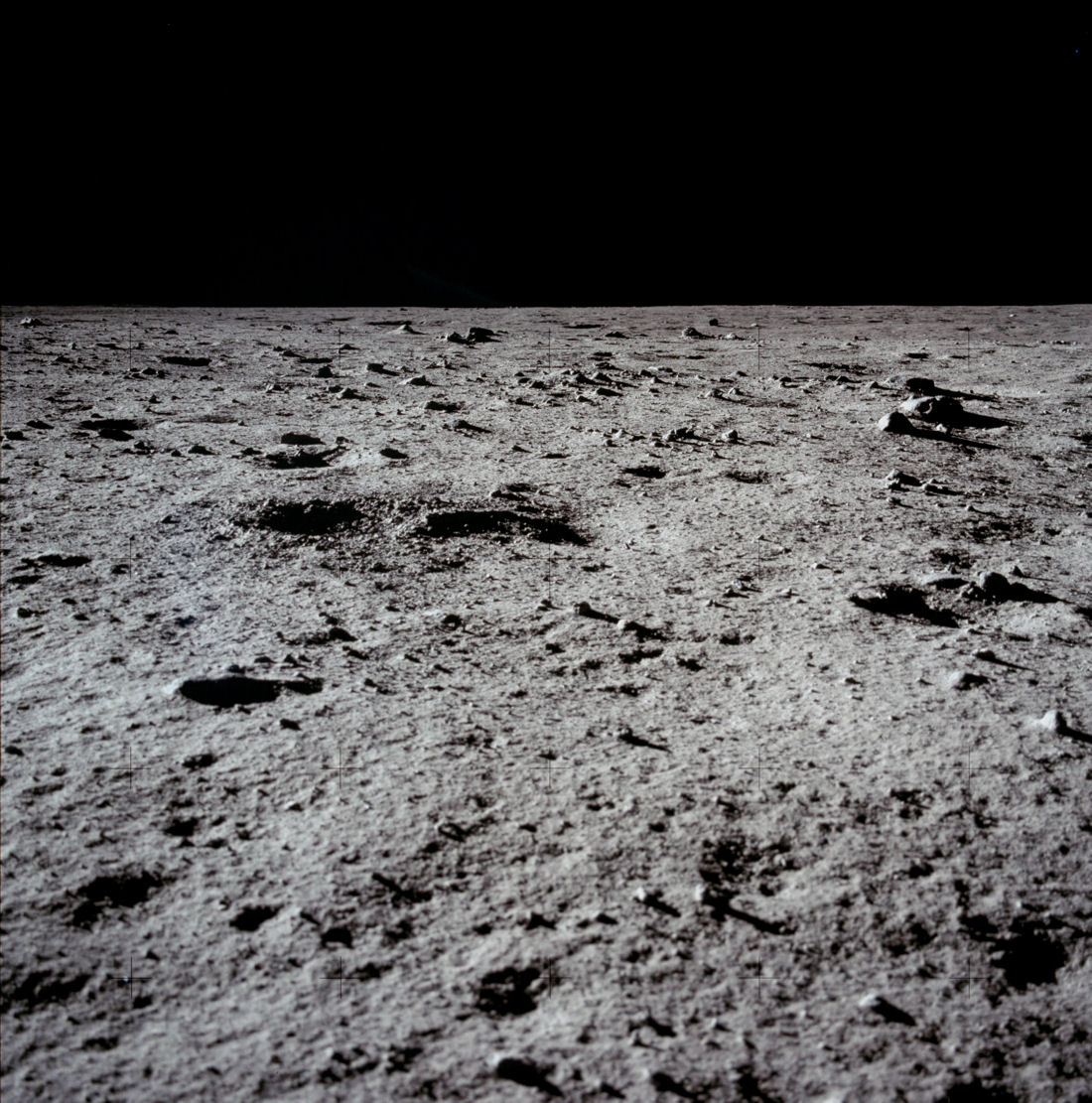
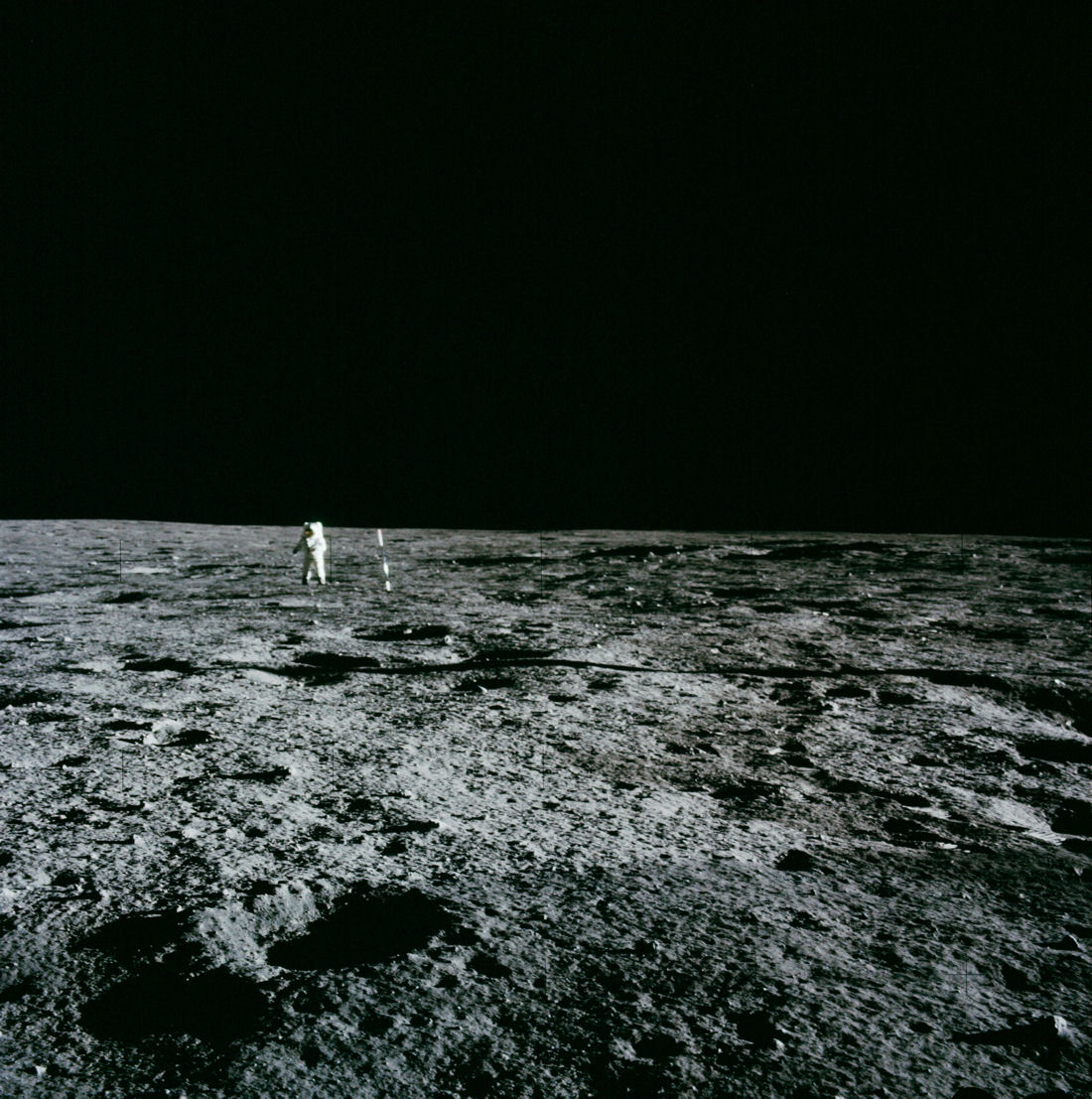
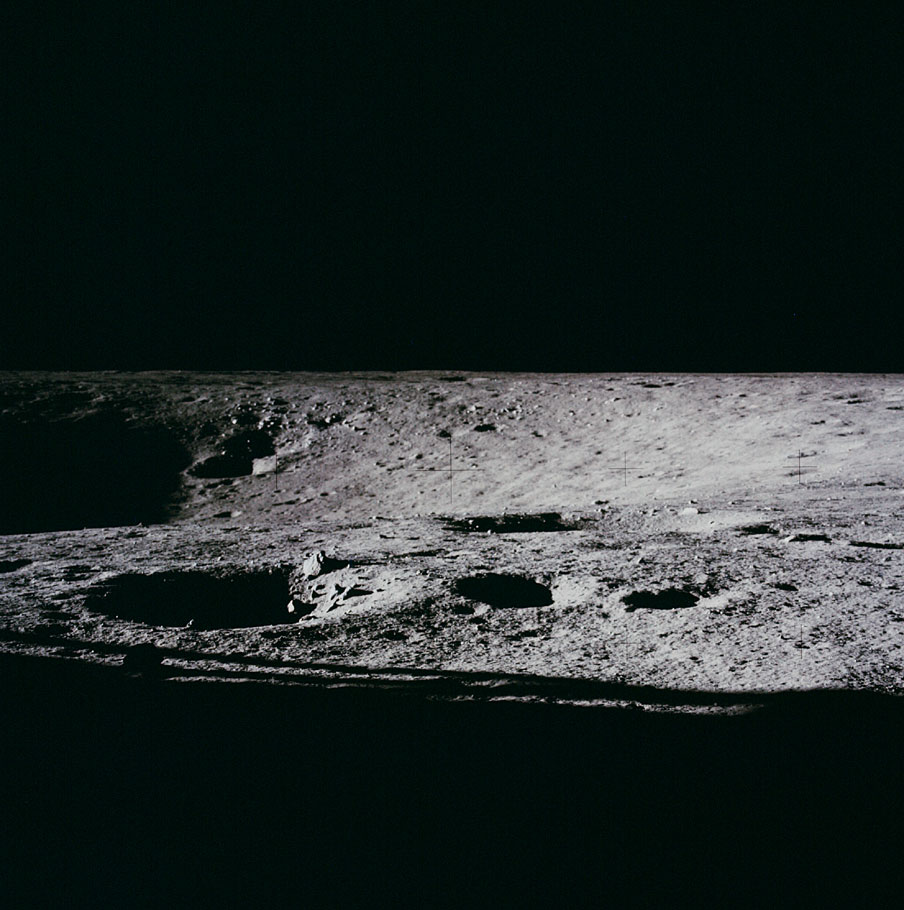
One thing that I love about the ‘debunking’ websites, by the way, is how frequently they contradict themselves while working their way through their ‘debunking’ checklists. The ever-pompous Phil Plait, proprietor of the appropriately named BadAstronomy.com website, is a prime example. Fairly early on in his ‘debunking’ rant, he writes as follows: “I’ll say this here now, and return to it many times: the Moon is not the Earth. Conditions there are weird, and our common sense is likely to fail us.”
Plait does indeed return to it often, whenever it advances his argument to do so, but he just as frequently tosses his own cardinal rule aside when that is what serves his purposes – like, for example, just four paragraphs later, when he advises readers to “go outside here on Earth on the darkest night imaginable and take a picture with the exact same camera settings the astronauts used, you won’t see any stars! It’s that simple.”
Ever the coy one, Phil doesn’t tell us what those “camera settings” are, but he clearly implies that the same settings were used in every photo, which clearly is not the case. Phil also conveniently forgets that the view from the Moon is not filtered through an atmosphere, so the stars have many times the luminosity as here on Earth. Phil’s little experiment, therefore, is entirely invalid, since he forgot to take into account that conditions on the Moon “are weird.” And as with all the ‘debunkers,’ he also forgot to explain why it is that no one thought to expose a photo or two to specifically capture the brilliant display of stars.
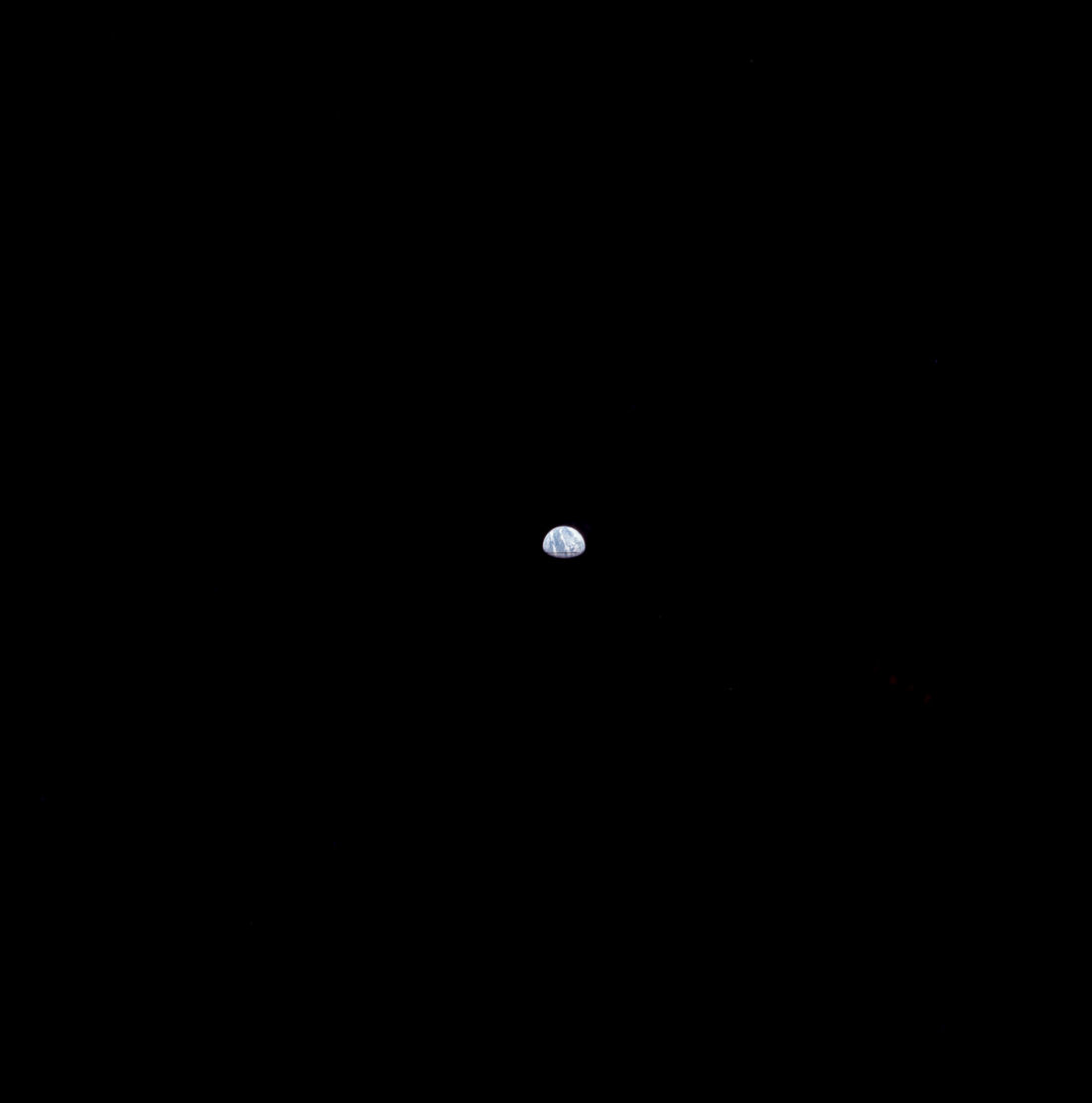
Legend holds that a dozen astronauts walked upon the surface of the Moon for varying amounts of time. The Apollo 17 astronauts alone were purportedly there for three days. For the duration of their visits, each of the twelve would have been treated to what was by far the most dazzling display of stars ever seen by the human eye. What they would have seen was many times more stars burning many times brighter than can be seen anywhere here on planet Earth.
Collectively, the dirty dozen took thousands of photos throughout their alleged journeys. And yet, amazingly enough, not one of them thought it might be a good idea to snap even a single photograph of such a wondrous sight. Of course, endless photos of the lunar modules and the monotonous lunar surface are exciting too, but just one or two photos of that dazzling lunar sky might have been nice as well. It’s as if someone went to Niagara Falls and the only photos they brought back were of the car they drove sitting in a nondescript parking lot.
Now let’s turn our attention to the subject of shadows. As skeptics have noted, some of NASA’s photos seem to depict nonparallel shadows, indicating more than one light source. ‘Debunkers’ have claimed that all such discrepancies can be explained by “perspective” and topographical variations on the surface of the Moon. And truth be told, many of the images that I have seen on websites on both sides of the aisle are ambiguous enough that such explanations can be plausibly argued. But there are, as it turns out, images in NASA’s collection that aren’t quite so easy to debunk.
There are, in fact, images that demonstrate unequivocally that more than one light source was used. Take, for example, the image below of one of the landing pods of the Apollo 11 lunar module, allegedly parked on the surface of the Moon.
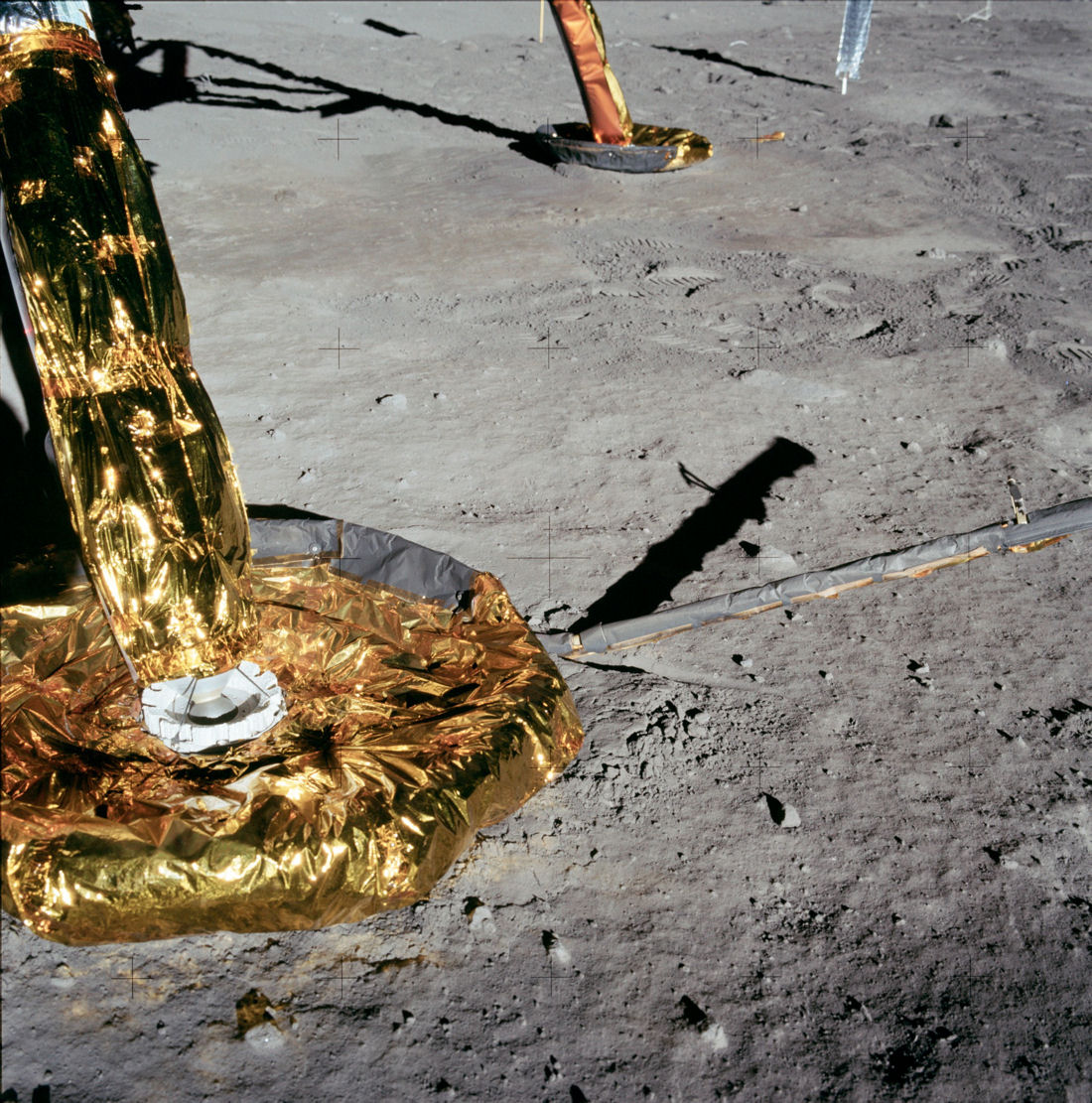
The primary light source, meant to simulate the sun, is obviously positioned to the right of the scene, as is clearly demonstrated by the shadows of all of the objects in the background. But there is just as obviously a secondary light source coming from the direction of the photographer. We know this because we can see in the foreground that the shadows coming off the small ‘Moon rocks’ point away from us. We know it also because we can see the light being reflected off of the gold foil wrap onto the ground in front of the pod. But we know it most of all because we can actually see the light reflected in the foil wrap on the leg of the pod!
The shadows in the foreground and in the background are at nearly right angles, a phenomenon that cannot, by any stretch of the imagination, be explained away as a perceptual problem – especially when we can clearly see the reflection of the secondary light! One other question concerning this particular photo: how do you suppose you would go about capturing such a low-angle shot with a chest-mounted camera? Was the astronaut/photographer standing in a foxhole?
The other issue involving shadows concerns the fact that, in the majority of the photos allegedly taken on the Moon, objects lying in the shadows are clearly visible even though, due to the Moon’s lack of atmosphere and the fact that sunlight therefore does not scatter, those shadowed areas should be completely black. The Moon, you see, is kind of a black and white world. If something is in the direct path of the unfiltered sunlight, it should be well lit (on one side); if it’s not, it should be as black as NASA’s starless lunar sky.
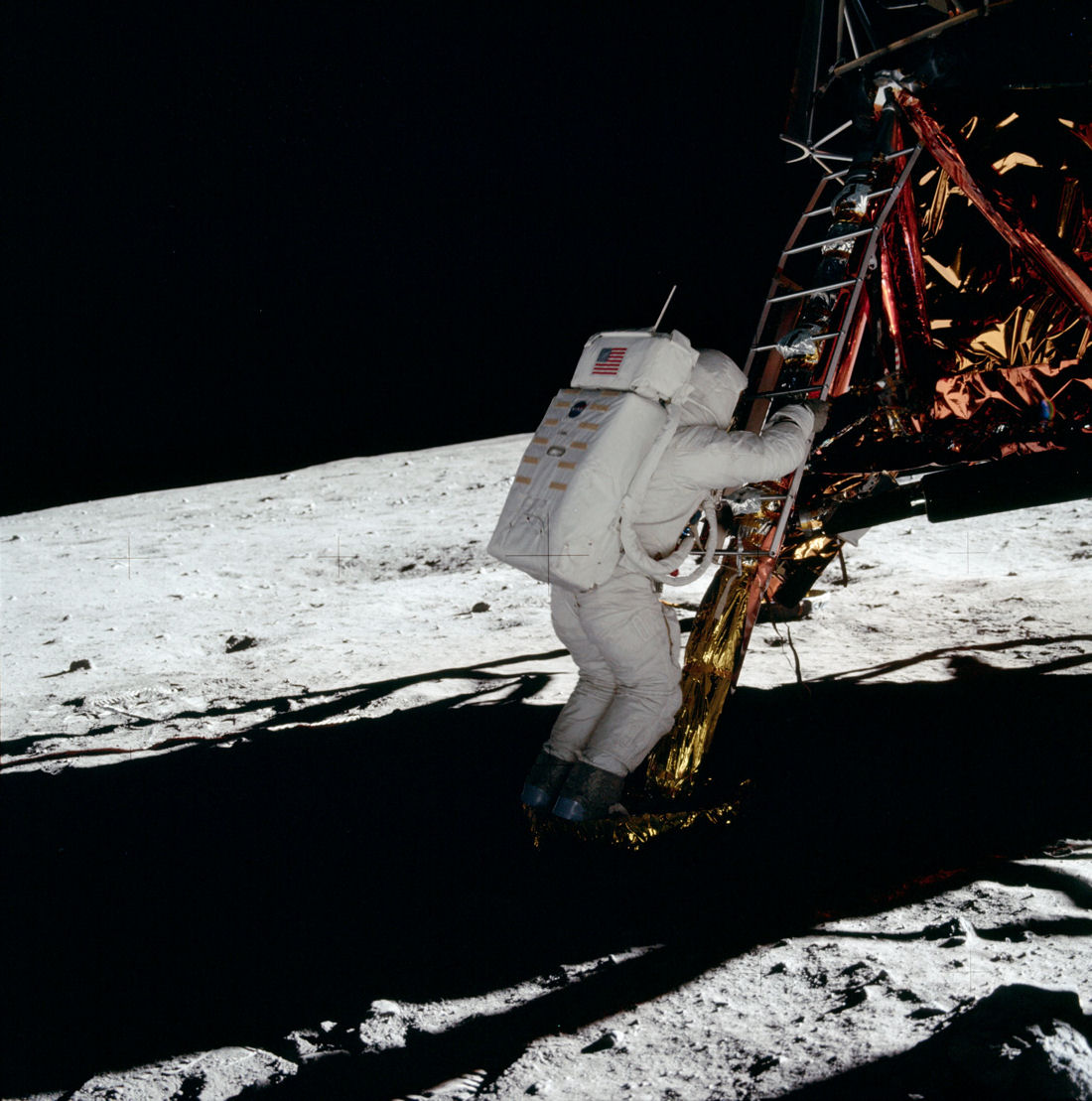
The ‘debunkers,’ of course, have an explanation for this. Let’s turn once again to BadAstronomy.com for that explanation, since that seems to be the website that all the other ‘debunking’ websites consistently reference and link to, the one that all the major media outlets endorse, and the one that even NASA apparently refers skeptics to. According to the site, “The lunar dust has a peculiar property: it tends to reflect light back in the direction from where it came.” Plait them goes on to provide the following explanation of the lighted shadows phenomenon: “Let’s say the sun is off to the right in a picture. It is illuminating the right side of the lander, and the left is in shadow. However, the sunlight falling beyond the lander on the left is being reflected back toward the Sun. That light hits the surface and reflects to the right and up, directly onto the shadowed part of the lander.”
In the previously cited example, Plait managed to make it through four entire paragraphs before contradicting himself. Here he has easily shattered that record by, incredibly enough, contradicting himself in back-to-back sentences! And this, keep in kind, seems to be the best ‘debunker’ that NASA has to offer (it is unclear whether Plait is a paid shill or simply a useful idiot; it other words, it is unclear whether he actually believes the stuff he writes or whether he is knowingly lying his ass off, but the latter seems far more likely).
Plait is right on the money when he says that the light falling beyond the LM on the left would be reflected “back toward the sun.” Unfortunately, he then immediately contradicts himself by claiming that that same light would be reflected “to the right,” onto the module. The only way that that could happen, as Plait surely knows, is if the light were to shine through the lander and reflect off the shaded portion of the soil. But that makes no sense, of course, just as Phil’s explanation makes no sense.
Light does not disperse on the Moon, as Plait himself notes elsewhere on his website. And the surface of the Moon (or at least what passes for the surface of the Moon in NASA’s photos) is not a very reflective surface, as can be clearly discerned in the photographs. Actually, it would be more accurate to say that the Moon is a very selectively reflective surface, with the light choosing to reflect only on the astronauts and on flags and other patriotic symbols.
Not too surprisingly, Plait once again invites readers to reproduce the effect right here at home, completely ignoring the fact that, as he himself has acknowledged, light behaves in entirely different ways here on Earth than it does on the Moon. Plait also claims that, “A nifty demonstration of the shadow filling was done by Ian Goddard and can be found here. His demos are great and really drive the point home.” In truth, Goddard’s “nifty demonstrations” are entirely dependent upon the effects of atmosphere causing the light to disperse, and thus they have no validity whatsoever.
I forgot to mention in the earlier discussion, by the way, that Plait also appealed to readers to conduct an Earth-bound experiment to ‘debunk’ the diverging shadows conundrum. According to Phil, “You can experience this for yourself; go outside on a clear day when the Sun is low in the sky and compare the direction of the shadows of near and far objects. You’ll see that they appear to diverge. Here is a major claim of the HBs that you can disprove all by yourself!”
Here is another experiment that Plait might want to try himself: go outside during the daytime on any day of your choosing and look up at the sky. If it is absolutely jet black, then feel free to continue advising your readers to conduct Moon simulations here at home. If it is blue, however (or gray, or white, or pretty much any color other than black), then stop pretending as though conditions on the Moon can be replicated here on Earth when we all know better (or we all should).
And when you’re done with that experiment? Give the camera-to-the-chest challenge a try and let everyone know how well that works out for you. And try to get some of those low-angle shots that NASA likes.
The truth is that even though a limited amount of light would reflect into the shadows, there is still way too much detail visible in the shadows in virtually all of NASA’s photos – if the arguments that NASA and Plait put forth earlier are at all accurate. As readers will recall, the earlier claim was that the lunar surface and the astronauts’ spacesuits were so dazzlingly bright in the unfiltered sunlight that very fast shutter speeds and very small apertures were required to avoid overexposing the shots.
The problem for NASA and its attack dogs is that you can’t have it both ways. If the camera is stopped down to avoid overexposing extremely bright highlights, it cannot simultaneously capture full detail in the shadows. And if the aperture and shutter speeds are set to capture detail in the shadows, the camera would necessarily also capture the brilliant stars, which would be far brighter than anything lying in the lunar shadows. Other planets would be pretty hard to miss in the lunar sky as well, though none can be seen in any of NASA’s photos.
Do you remember, by the way, what Windley told us earlier about the relationship between the aperture setting and depth of field? The basic rule is that the smaller the aperture setting, the greater the depth of field will be. With a wide aperture, conversely, the photo will have little depth of field. That is why portrait photographers tend to shoot with the lens wide open, to deliberately isolate the subject from foreground and background elements. Landscape photographers, on the other hand, stop the lens down to keep the entire scene in focus.
With that bit of basic photographic knowledge in hand, it is fairly easy to determine whether NASA’s photographs were, in fact, taken with a very small aperture setting. And a good place to start, I suppose, is with the very first photo allegedly taken by a man standing on lunar soil. Below is what is alleged to be Armstrong’s very first attempt at lunar photography, just after climbing down from the module.
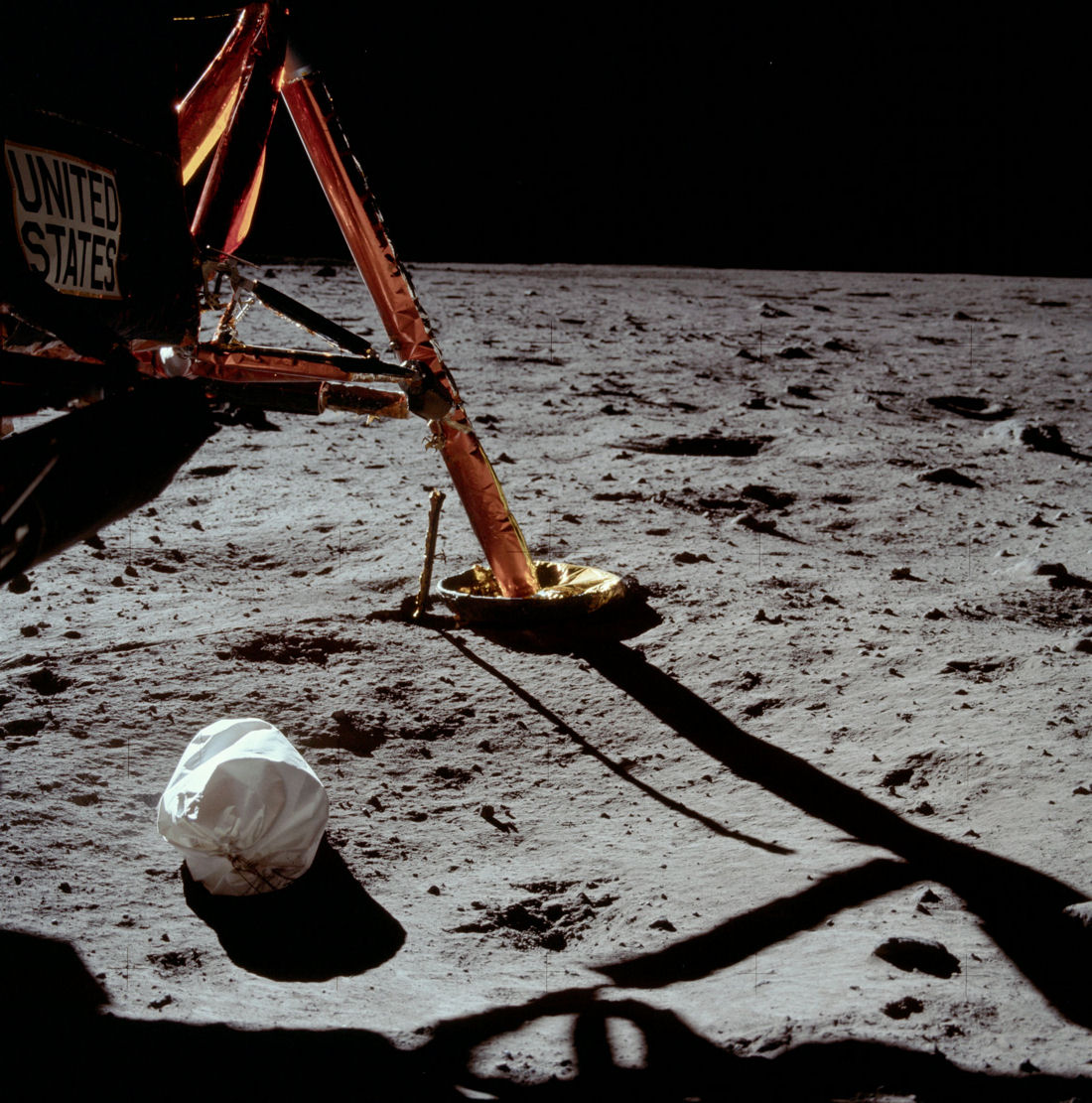
First off, I think we can all agree that, under the circumstances, it’s a pretty damn good first effort. There are problems right off the bat, of course, with the fact that the shadows are obviously lit with a diffused secondary light source, or else we wouldn’t be able to see the top of the bag, or the United States sign, or the shadowed side of the landing strut, but what we’re really looking for here is depth of field, which this photo has very little of. The photographer has focused on the United States sign (and he did it blindly!), but little else is sharply focused. Hence we know, from the very first shot, that the ‘debunkers’ are lying about the exposure settings.
Moving on to Armstrong’s second alleged photo, seen below, we again find that there is very little depth of field. Both the foreground and the background are quite blurry, indicating that it clearly was not taken with a small aperture setting. And yet there is nary a star to be seen.
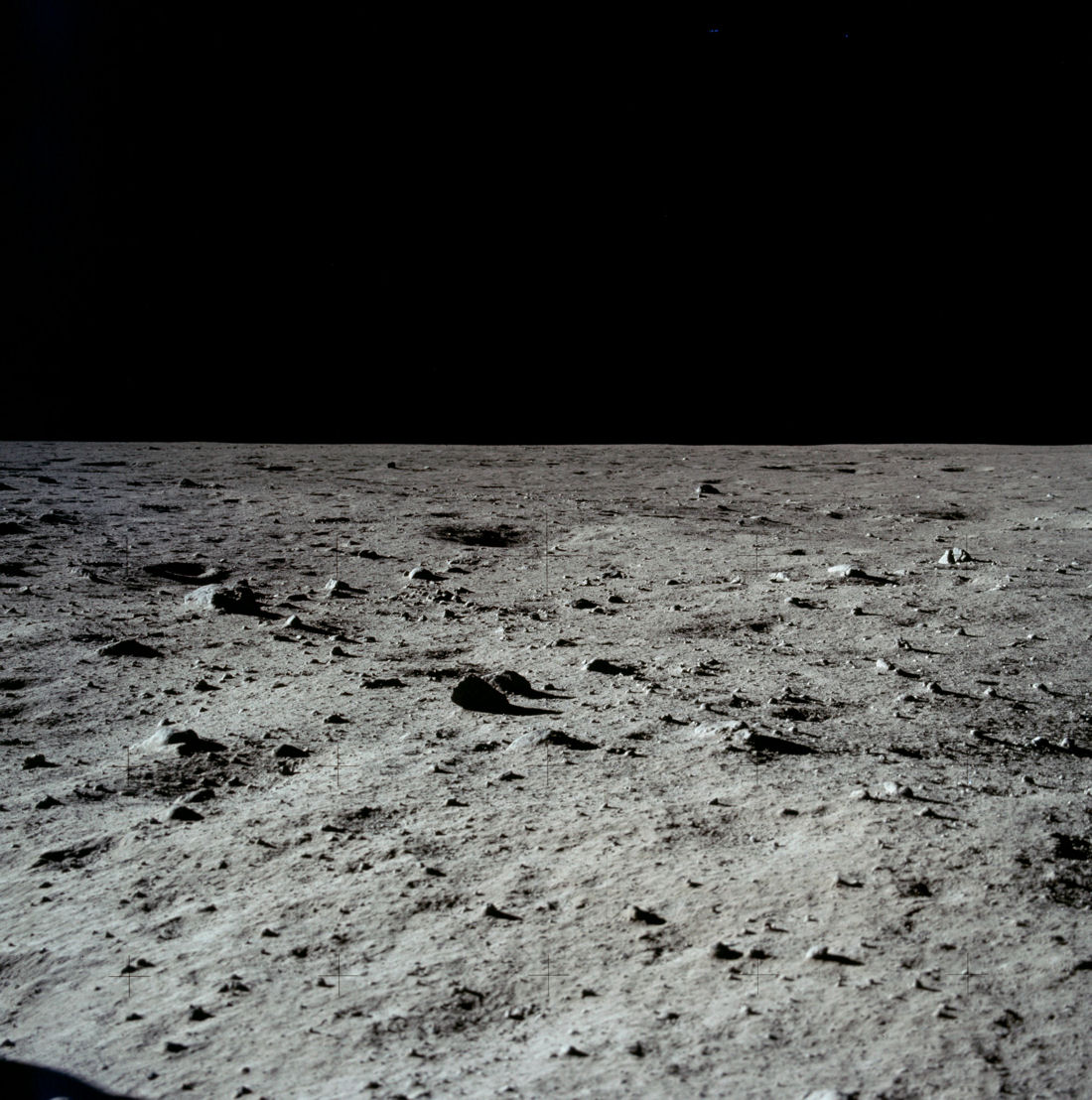
Before moving on, there is one more of Armstrong’s photos that I feel obligated to present here. It is, after all, his masterpiece, as well as being probably the most iconic of all the Apollo photos. I am talking, of course, about the so-called “Man on the Moon” shot of cohort Buzz Aldrin, seen below (which is probably not actually Aldrin; my guess is that the same two actors did all the Moonwalking in the videos and photos from the alleged missions).
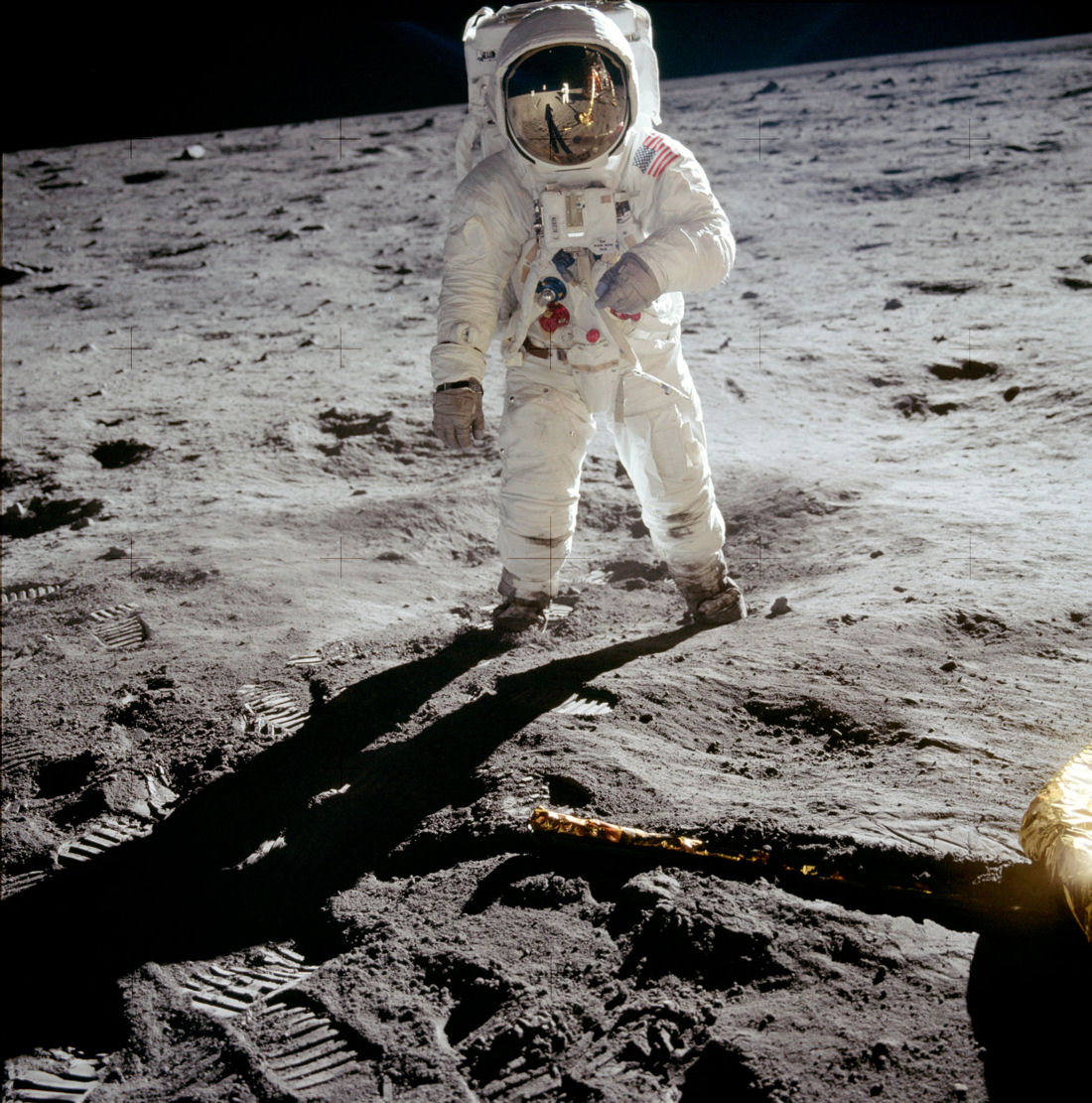
We must first, of course, compliment Neil on the awesome composition. It hardly looks staged at all. But there are problems here. Once again, I’m just not seeing the depth of field that Windley promised us. It’s also pretty hard not to notice that Buzz’s spacesuit isn’t pressurized. Furthermore, the surface of the ‘Moon’ is quite unevenly lit, indicating that the light source used was much closer than the sun. And then there is the noticeable lack of any shadowing on Buzz’s spacesuit. He’s casting a shadow on the ground, but there is no corresponding shadowing of his body. Even here on Earth, that is only possible with a secondary light source.
There are some photos in NASA’s collection that were taken without a secondary light source, so we do know what fake Moon landing pictures should look like. The action shot below of the lunar rover, for example, was taken without a secondary light to fill in the shadows. The shadows still aren’t quite as dark as they would be on the Moon, but the difference between a fake Moon shot taken with a fill light and a fake Moon shot taken without a fill light couldn’t be more obvious.
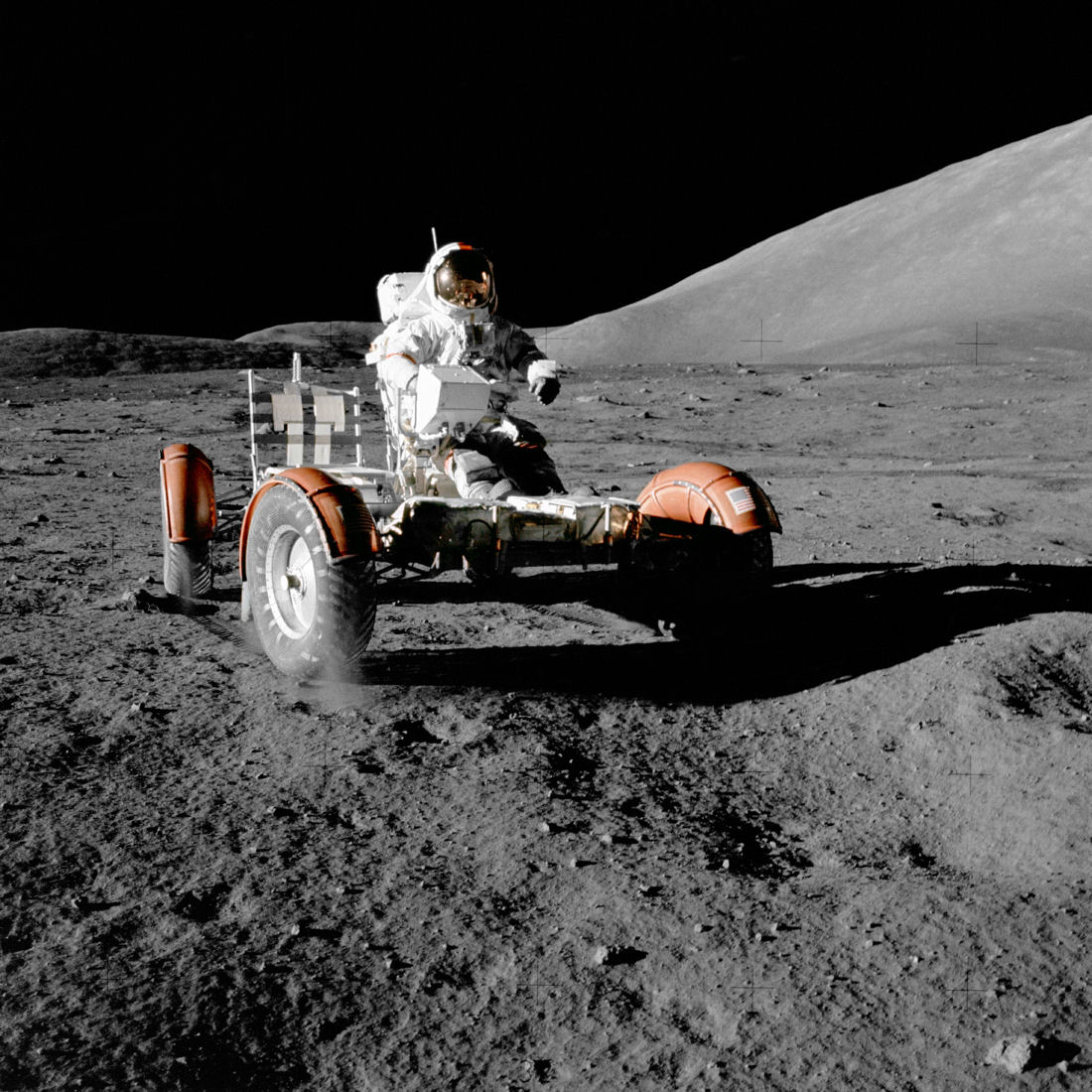
NASA liked the “Man on the Moon” image so much, by the way, that they essentially restaged it for the Apollo 12 mission. As can be seen below, a secondary light was used for that shot as well. Without the fill light, there is simply no way that a portion of the astronaut’s spacesuit would not be shadowed, as it is in the rover photo above.
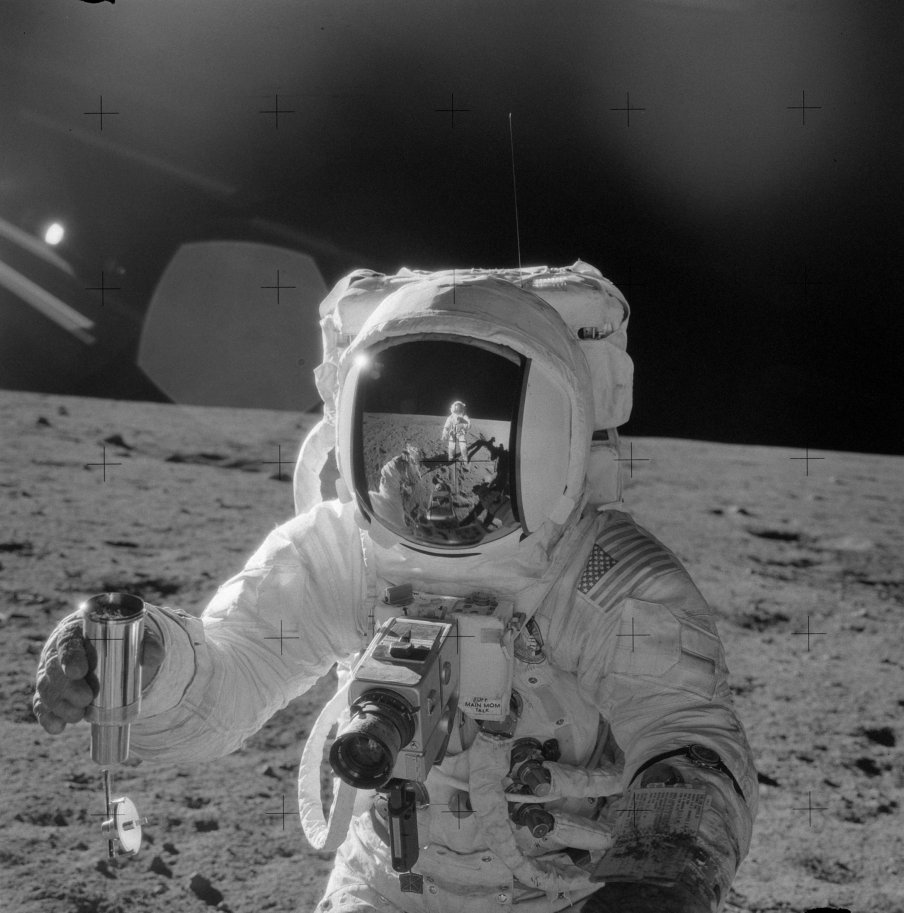
Moving on then to the next issue, we have the mystery of the disappearing crosshairs. The problem, according to skeptics, is that the crosshair reference marks, which were etched into the camera’s lenses and therefore should always appear on top of any objects in the photos, sometimes disappear behind those objects.
Plait actually gets this one correct in explaining the phenomenon as a problem of overexposure and contrast. When some of the brighter objects in the photos are overexposed, the fine crosshairs tend to get washed out. That is in fact a reasonable explanation for the effect (by the way, I mentioned before that I was not a rocket scientist; I am, however, a photographer).
The claim that the cross-hairs should be visible presupposes that NASA added objects to the photos, creating composites. I seriously doubt though that that would have happened. The scenes appear to have been very carefully staged before the photos were taken, so there would have been no need for cutting and pasting. And if NASA had planned on adding additional elements to the photos, I doubt that they would have complicated that process by using cameras with cross-hairs; it would have been much easier to create the composites first and then overlay the grid marks on top of them.
However … the same can certainly not be said of the images that purport to show various parts of the ship flying through space. Take the image below, for example, which is supposed to be a two-dimensional rendering of a three-dimensional scene of the command and service modules in lunar orbit. If it were an actual three-dimensional scene, the spaceship would be 69 miles above the lunar surface – which would, I would think, make it difficult for a portion of that lunar terrain to obscure part of the ship’s S-band antennae assembly.
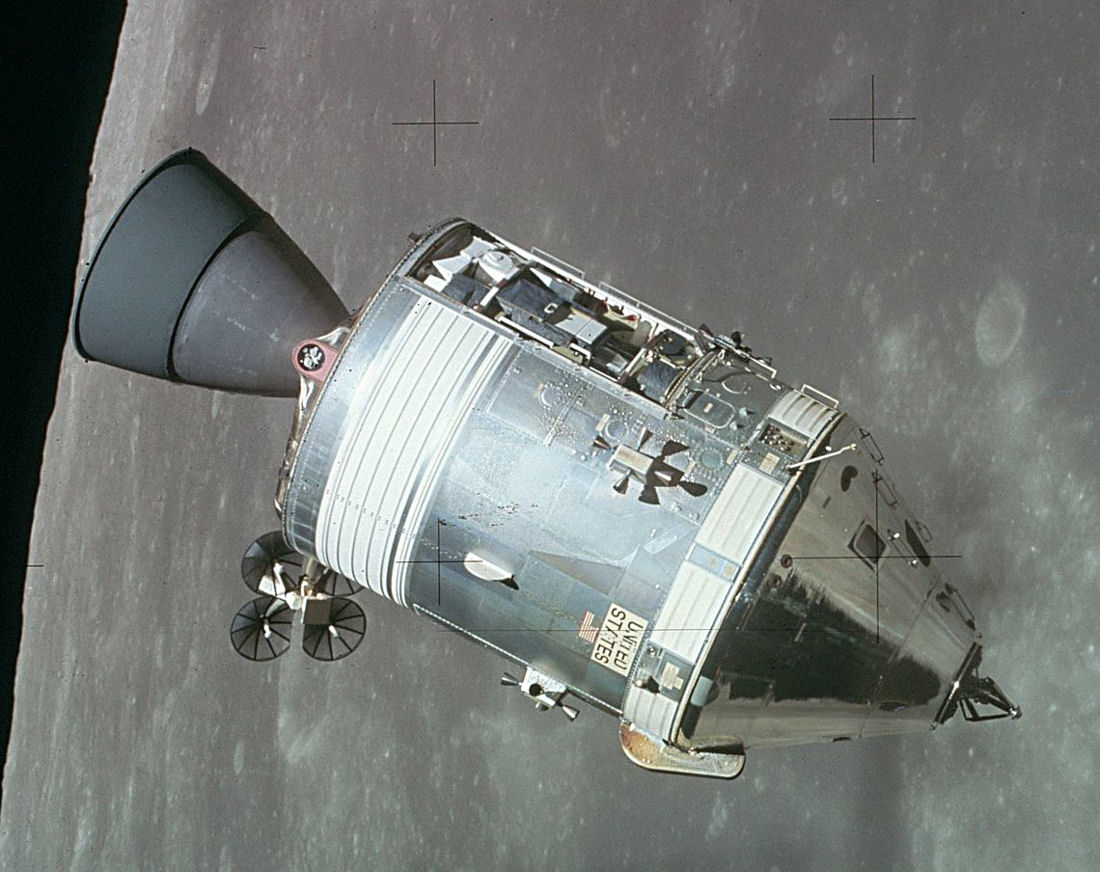
The shot, as can be seen in the enlargement below, is clearly a composite. And not even a very good one. So it is entirely possible that some of the photos allegedly shot on the Moon are composites as well. I obviously haven’t studied every one of them. I’m just saying that the ones that I have seen that have disappearing crosshairs do not appear to be composites.
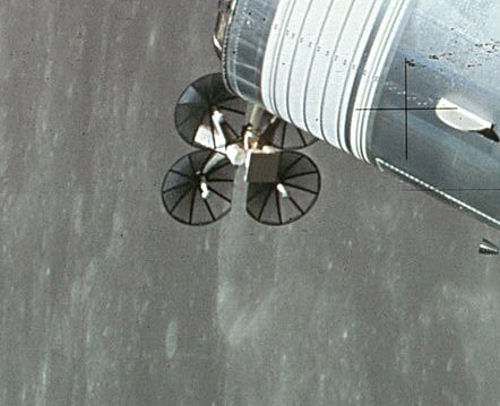
The next problem with the NASA photos is that some of them seem to have identical backgrounds but different foregrounds. As Phil Plait explains, “In one [photo], they show the lunar lander with a mountain in the background. They then show another picture of the same mountain, but no lander in the foreground at all. The astronauts could not have taken either picture before landing, of course, and after it lifts off the lander leaves the bottom section behind. Therefore, there would have been something in the second image no matter what, and the foreground could not be empty.”
Plait begins his debunking by stating, rather hilariously: “As always, repeat after me: the Moon is not the Earth.” Plait goes on to claim that distances are very difficult to judge on the Moon and that the two photographs were actually taken from much different angles, and yet the background remains virtually unchanged because, despite appearances, it is a really, really long ways away. Either that, or one of the astronauts was really David Copperfield.
The two photographs appear below. I’ll leave it to readers to decide whether, as Plait claims, the ‘mountains’ are in fact many, many times further away from the lander than the lander is from the photographer. And I’ll do so while noting that Phil provides neither the photographs nor a link to them, but instead asks readers to accept what he says on faith. I wonder why he would do that if he were so sure of his conclusions? I also wonder why, in the final photo, the lander appears to be parked much closer to the ‘mountains’ than Plait would have us believe.
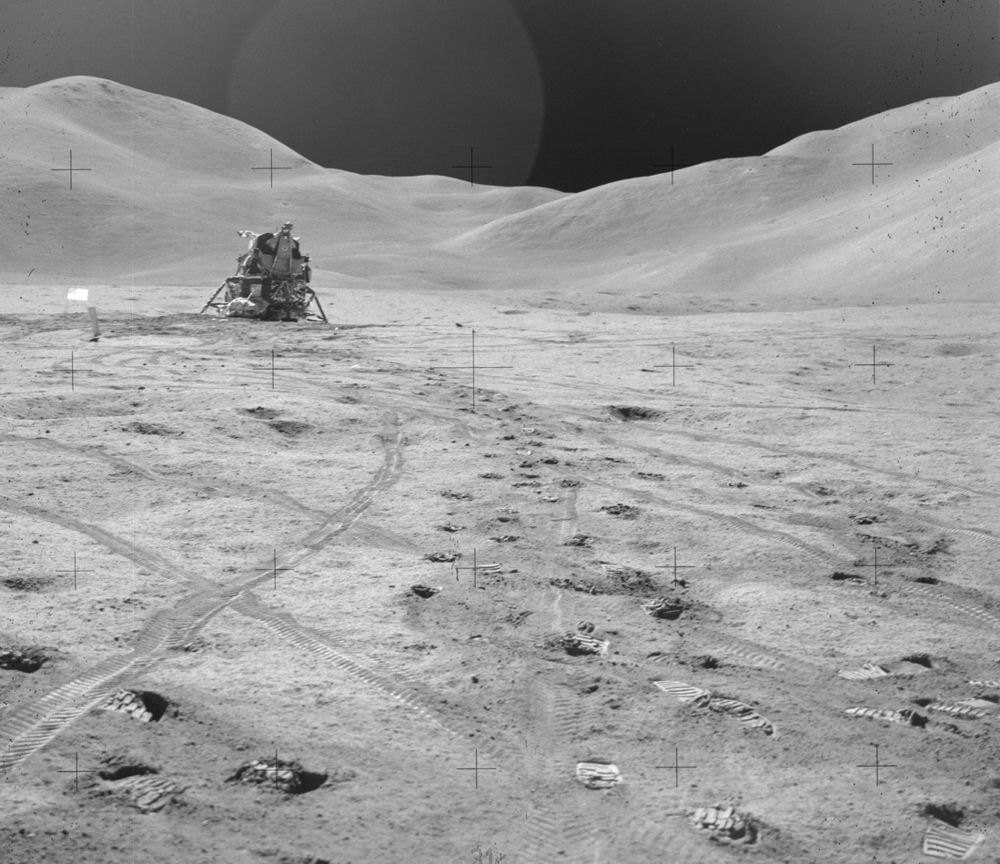
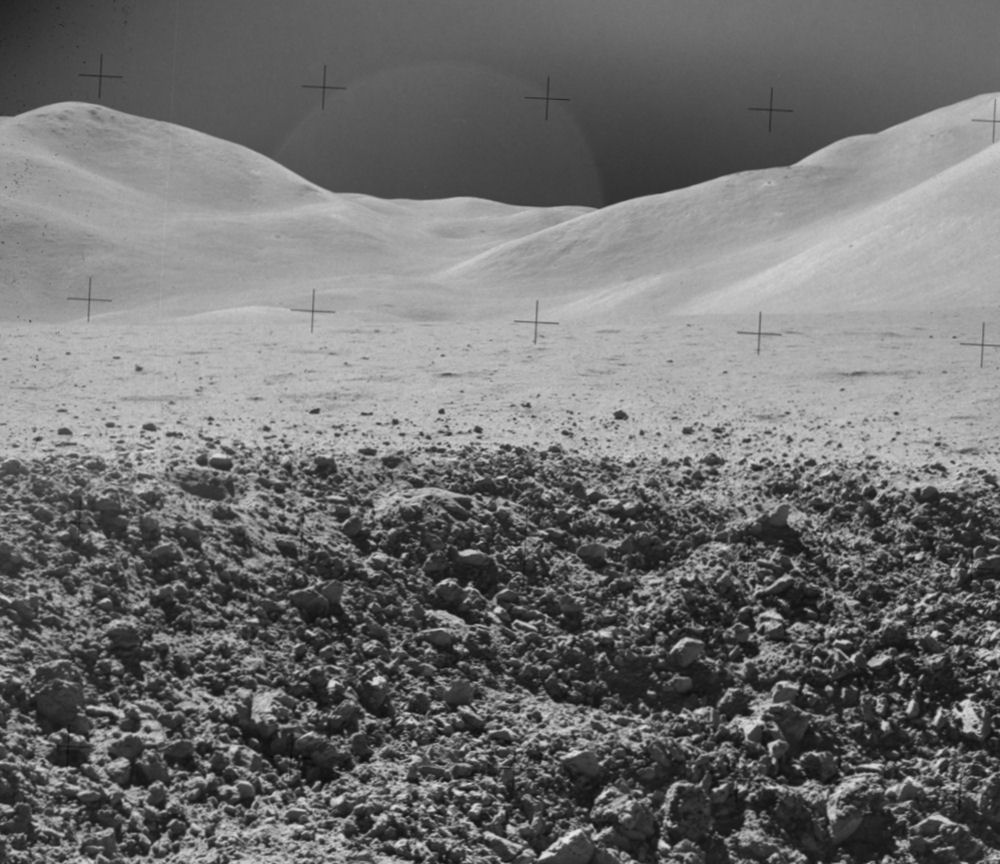
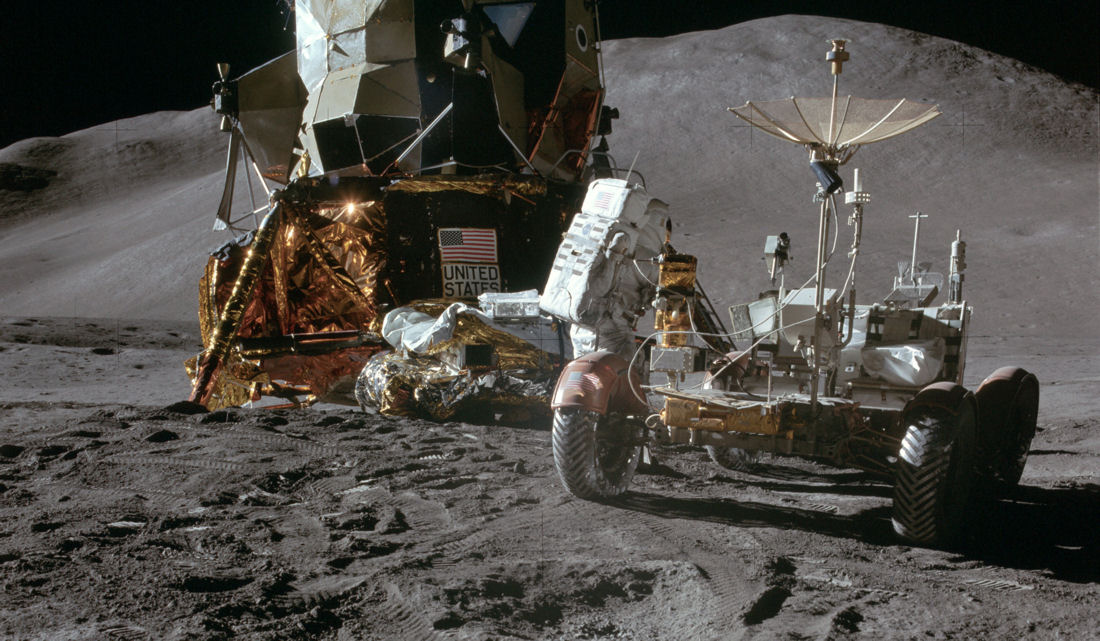

Is this comments field still active? Seems strange that no one has commented in the last 8 years? Does the author still stand by the comments in this article?
Cheers, John.
Dave (the author) passed away in November of 2015. The original website did not allow comments, and this one was only built after his death. There are several comments on pieces throughout the site.
The site was taken down after the author passed away, and redesigned and put back up at the direction of his oldest daughter. I don’t even know if comments were possible on the old site. I don’t remember there being a comment section before, but I may be wrong.
I thank GOD for honest men. If the truth, no matter how unpopular, is not spoken then we are lost…
The S-band antennas are not obscured by the ground. The antennas are all truncated circles (parabolas). Look at them closely. They CANNOT be fully circular because they are so close to each other that there would be overlapping portions of each antenna. They don’t NEED to be full circular parabolas to work. They are easily 90% fully complete parabolas. Y’all are making literal mountains out of literal molehills.
I’m going to correct myself on one “anomaly” I agreed with initially: the apparent divergent angles of the shadows in the photo of the landing footpad on the LEM. I have realized that the shadow is not, in fact, divergent at all. The pole sticking out to create that shadow is one of the simple ground sensors that stuck straight down from the bottom of each pad. It gave the astronauts inside indication that they were in contact with the ground on landing and could shut down the engine. On contact with the ground the rods bend and that’s what you see. It happens to be at a perpendicular angle to the sun in the photo so it’s longitudinal shadow LOOKS like it’s pointing the wrong way but it isn’t. You can see my explanation is correct because the shade is fattened instead of narrow like the rod shadow would be if the light source was coming from the astronaut’s direction. Also, as previously mentioned, the pebbles/rocks in the foreground also have shadows EXCLUSIVELY pointing the correct direction. If they were illuminated by a second source close to the astronaut, they would share shadows in the wrong direction. At the very least they would have double shadows.
Mr. ONeil, none of your rebuttals matter (I agree, too, that some of the anomalies described are hardly worth including). The fact remains that the film could not have survived the extremes of temperature. And it certainly could not have endured the radiation without at least *some* fogging. That is hardly a molehill. The clarity of the images alone is proof that the photos could not have been taken on the Moon.
Hi Alissa,
I am sorry to hear that Dave has passed away, my comment does seem out of place now. Condolences to all who knew and cared for him.
Best regards
John.
Uh… The photo of the astronaut with the camera on his chest clearly shows he would have no problem at all in seeing most of it. The chest rig and the camera and lense clearly project far enough forward that it would be no problem to just look down and see the entire top of the camera plus lense.
The moonshots and landing were/are a ruse. We,America have never been to the moon.
Dave: RIP
So; everyone here actually believes the USSR would let us get away with a faked moon landing? Not a chance.
As for the Dutch Moon Rock: So; some disgruntled person swapped it after NASA handed it over to some politician.
I hope the Laurel Canyon book I just bought is not loaded with too much of this.
If you leave your radio on for several hours your car is dead. But the “magic” five car batteries powered the Lunar Lander for days, sent hundreds of hours of radio and television signals back to the Earth over millions of miles, provided heating, cooling and propulsion for days on end, plus power to all the equipment the Astro-NOTS used. Has anyone ever seen how large the power plants are that power a radio station or do you think they just run them off five car batteries. NASA must have “forgot” or thrown away the plans for these magic batteries too!!!! Some many impossibilities exist it is really quite fun watching these idiots try to explain away the 1000’s of facts, science and math that absolutely proves man has never been to the moon nor will he get beyond the Van Allen Radiation Belts any time soon.
Not only did the Wall Street created USSR “allow” the Wall Street dominated USA to fake the Moon landings, but Russia maintained the ruse narrative of both 9/11 and the Covid scam. There are no “sides,” and it is near impossible to determine when there ever were.
What isn’t even addressed is, we had live (?) TV coverage from the Moon? How huge were TV cameras then and what sort of antenna did they use? Batteries for all of this went where?
I would enjoy full “coverage” of the feat of live TV coverage from the Moon, as well — here’s hoping someone gets inspired by these articles, to give that a go!
He covers it on Part I, in his fantastic way of putting things, they couldn’t even transmit clearly from the middle east thirty years later but in the 60’s they had that misteriously lost technology.
As an old 11C infantryman, those legs and landing pads look very similar to mortar tubes; anyone with me there? Even the bipod legs look like theyre incorporated?
One thing not covered here is that on a Hasselblad camera, the rolls of film only contain 12 exposures. How in the hell did they swap out rolls of film while wearing gloves? I’ve shot many rolls on a Hasselblad and I can say without hesitation that it is not an easy camera to use and that it is completely impossible that these photos we have are really from the moon.
David, I was a pro photographer for over 30 years. I’ve shot Hasselblad for decades. The film backs available were 12 exposure, (120 film) 24 exposure (220 film) and 70mm which was 100 exposure. The fake moon landing shots were made on the 70mm back.
The camera was a special design. You can’t see that design because it disappeared with all the other Apollo program data. But if you could see it you would see it was a special design with lots of film, big buttons and latches for day, stiff gloves, etc. But you can’t because all that stuff got lost.
I’ve operated a 70mm Forox camera used copy work that my company purchased from Disney. It had a relatively small film canister (@8″x4″x3″) that held 1000 frame rolls of 70mm film
Superb article. Sad to hear Dave has passed, however this is a great legacy.
I wonder what skeptics claimed that the lenses were etched with hash marks.
It would make zero sense to etch crosshairs into lenses, because it wouldn’t result in hash marks on the images, anyway, since the lens “sees” beyond any surface scratches. All that would do would be to introduce anomalies on the lens surface that could result in some lens flare.
I used to work in radiation safety at a research reactor. There is a reason that old-style devices to measure your personal radiation exposure were called “film badges” (some are still in use, but my workplace had gone to Li crystals).
Wikipedia says the astronauts received anywhere from ~1.5R to ~2.5R over the course of a mission. This ain’t no thang for people — but there is no way the film (which received the same amount, ballparkwise) could have remained unfogged. It would not have been completely whited out, but it would have been at least grainy and foggy.
For this reason, I don’t care what’s actually IN any of the footage. The fact that it is all *crystal* clear is proof enough that that film, at least, never left Earth.
My theory is, there were of course “sets” — they were for training, to accustom the guys to what things might be like on the Moon. And of course they took pictures and video of the training sessions. I think they took the training footage and passed it off as the real thing.
Thanks very much for these thorough & empirically based observations of ‘men on the Moon’ — which has not been duplicated these 5 decades later by any Nation. “We had Hollywood, the USSR did not”
Regarding the use of cameras, refer to the YouTube video:
https://www.youtube.com/watch?v=0h8a29J4QT0
At about the 2:00 mark, you can see the astronaut inserting film into a camera. And the camera does indeed detach from the chest so that you can carry it by hand.
At 21:40 you can see one astronaut taking a picture of the other. He does not hold the camera up to his face/helmet, but shoots from the chest. At 22:13 you can get a pretty good look at what the camera (held in the astronaut’s hand) looks like.
I have only recently (2019) started studying the Apollo story. Thanks to Dave McGowan and others I have come to know the truth about this hoax. Like he says: if they can lie about this they will lie about everything. It’s wonderful that there are people like him that keep fighting for the truth to be known.
Curious as to why the lunar rover has fenders. I have looked at other rovers and none have motorcycle fenders like this one does. Hmmmm.
I can go after this argument of shadows being illuminated quite easily without torturous reasoning. Here you go: you can actually see the illuminated lunar surface in detail from all angles. There you go. What? Think about how your eyes work. You only see because light reflects off of everything you “see”. If the sun (or other form of illumination) is off to your 3 o’clock and you are looking perpendicular to the light at your surroundings, in order for you to see it all requires the light be reflected at you for your eyes to see! The light IS scattering in ALL directions because you can see the ground from ALL directions. The ONLY scattering lacking on the moon is that caused by an atmosphere which, on earth, is miniscule at ground level. Clear air doesn’t scatter light much at all or everything you looked at would be blurred AND you would not be able to see stars in the night sky because those pinpoint sources of light have to travel through 100s of miles, even thousands if you are looking towards the horizon, for you to see them. If the atmosphere were so great at scattering light the night sky wouldn’t have sharp pinpoint of light and a clear view of the moon. It would just be a blurry mess with slightly light blotches where the brightest stars are.
Thus, the light from ALL directions on the lunar surface is scattering (reflecting) in ALL DIRECTIONS or you wouldn’t see anything and some of that light is reflecting of the astronaut and lander as physics requires. The picture featured of the disparate shadow angles (at right angles to each other) IS truly a poser and suspicious. However, also note the small pebbles on the ground leading up to the lander footpad in the foreground. Why is that one shadow perpendicular to the other shadows INCLUDING THOSE OF THE PEBBLES IN THE FOREGROUND? The pebbles closest to the astronaut taking the photo should also have shadows perpendicular to the background unless the secondary light apparently used is magically specific only for lander parts. The pebbles should actually have 2 shadows perpendicular to each other to match the two light sources.
I don’t want to ruffle any feathers, but I don’t think all of what Dave writes here is accurate. I agree with many of the problems he presents (especially focusing the cameras and changing the rolls of film in the spacesuits) and I’m very familiar with the arrogance of many ‘debunkers’. But I do have some common sense problems with the issues presented here.
That none of the photos show stars is just not true if you zoom in on the high-res versions of some, you can make out a few specks on the black horizon. Some examples: https://www.hq.nasa.gov/office/pao/History/alsj/a11/AS11-37-5454HR.jpg
https://www.hq.nasa.gov/office/pao/History/alsj/a11/AS11-40-5948HR.jpg
and especially: https://www.hq.nasa.gov/office/pao/History/alsj/a11/AS11-40-5967HR.jpg
Looks to me that these photos are really just underexposed, so the stars are only barely visible.
The image which Dave sais unequivocally demonstrates that there are two light sources also looks quite normal to me. If you look at some of the other photos like https://www.hq.nasa.gov/office/pao/History/alsj/a11/AS11-40-5865.jpg you can see the strut besides the landing pod is sticking up and to the side at an angle and the rod above the ‘footpad’ is also at an angle. That’s why there seems to be a light source to the right in Dave’s photo. The shadow of the rod in the background is towards the left of the rod because the rod itself leans to the left, while the only source of light seems to be behind the cameraman.
Now the ‘man on the moon’ photo. It seems to me, that the extra light source illuminating Aldrin spacesuit from the front, is simply the reflection of the sunlight off of Armstrongs spacesuit and off of the gold foil of the lander. The lunar surface doesn’t reflect the light in this way, but the spacesuits are bright white and the foil definitely reflects light. That’s also why it looks so different on other photos where there is no reflective object near.
As an Astro photographer, I can say 100% that those are not stars in those images.
1. Most these images have a pretty shallow depth of field (DOF), ie. they are focused pretty close and shot wide-open. So now look at the horizon and see how out of focus it is. The stars should be equally if not more blurred. And they would appear as bokeh discs, not blobs, as stars are basically perfect point light sources.
2. There is no comatic aberration on the “stars”, notice how they look basically identical all across the frame. This would be impossible with the 60mm Zeiss Biogon lens they were using, especially shooting wide-open as it is not an aspherical lens with coma correction. The “stars” should look smeared and appear to have a tail towards the edges of the frame.
3. Most of these “stars” are blue, this is impossible as 80% of the stars in the universe are in their red giant stage; so this means that no matter what part of the sky you’re looking at ~80% of the stars in your image will always be yellow, not blue. I have tested this numerous times.
Summing up, given these spots do not sit in the frame as seen from the depth of field, I can only say it is some kind of artifact on the film itself, or imperfections (leaks, flares, reflections) from the rear screen projection on set, or they have been composited in after the fact.
No matter what the reason, these are not stars.
Hi Brendan,
This is an excellent, excellent, excellent comment. Absolutely correct what you say (except the 80% of stars are red giant stage part). It’s a fascinating topic independently of whether the moon landings happened or not: why are there no stars in the photos?
Perhaps the landings didn’t happen, or perhaps Space is not what we think it is and stars are not visible. Or geometry is non-Euclidean at some point beyond LEO (and including on the Moon) and light behaves differently, and issues of photographic focus become almost incomprehensible. Astronauts in interviews following Apollo 11 state they cannot recall seeing stars in cis-lunar space or from the surface. I’m curious.
Your comment is excellent: stars, if they were to appear in the images, and the photographic environment is assumed to be similar to Earth, would not be pinpoints as they are when in focus.
15 when they ‘landed’ awesome! …but not many years b4 i started questioning. a graphic artist with my own darkroom i grew up with the same photographic technology as then. i’m pretty much in alignment with author. we all have a little we can add or detract, & as a mechanic & diver have an all round understanding of issues involved. with all data destroyed a proper forensic aint a go… but sitting here in 2021 ‘fraid dont need it. never went, never landed, & like the covid fraud & its horrifying ‘vaccination’ con that is changing the world as we know it because 90% of humanity are fooled even now today.
loved dave’s delivery, so readable, cant fault findings. a reminder we have to view ALL history with facts not popular narrative. ie, evidence for the ‘holocaust?’ srry. another political stunt.
https://www.bitchute.com/video/C0cGS0TK5Dwn/
For those asking why Russia never debunked the fakery:
1. some sort of “real” space stuff was happening just not the Apollo twaddle;
2. throughout the “cold war”, America was literally feeding Russia, sending megatons of grain a year to the losers who were also propped up by Wall Street loans (like China in 2022). If they wanted a mass starvation disaster to end them, all Russia had to do was make trouble for the people really running everything.
Frank, Nailed it. No grain for taddle-tails. Russia needed to eat.
Excellent Work! Dave remains a true Hero in every sense!
It is too bad Dave died at such a young age. I can only imagine what he would be writing about these days…We surely need his insight and humor now.
I tend to agree that the landings were an elaborate hoax, but trying to prove it by the lighting in the photos doesn’t hold up. It’s true that light is reflected but not in the manner described in this article. Elementary physics holds that angle of reflection=angle of incidence. So when sunlight strikes the surface of the moon it is reflected in the direction that corresponds to the plane of the surface. That surface is irregular (multifaceted) and produces what is called light splash. With photons bouncing off in many directions it creates enough light to fill shadows areas. Think of the irregular surface as a diffuser. Good photographers know the not so secret method of using a linear or hard light source in combination with a bounced diffused light source creates a fill in the shaded areas of the subject in the photo.
I have a question concerning the American flag patch on the left shoulder of the suit. Given that the light side of the Moon reaches temperatures of 260 F, would it not happen that the stitched materials would smolder or potentially catch fire?
That’s too cool for most fabrics, which don’t burn till closer to 300F (for silk) or more (400+ for polyester). More to the point, though, there is no air for either smoldering or flaming.
Photographic film melts at 150F.
Alissa, Hello !!
Thank You For Not Posting My Comment From Yesterday 1-9-25 About The Lack of Dust and Thrust Crater Underneath The LM
As Soon As I Began Reading Part V I Realized I Had Read Dave’s Moondoggie Report Years Ago On His Original Site As I Was Reading The Laurel Canyon Research As He Posted It Chapter By Chapter
I Was Most Grateful To Have Found His “Old School” Site Back Then and Most Grateful To Have Found This New Site You Have Put Together, Making His Great Research, And Then Some Available Again
Kudos and Thanks Again For Not Embarrassing Me And For Putting This Site Up
When Finances Allow I Will Help
Sincerely and With Much Regard,
Scott Bandalos
Hi, Scott! I’m glad it worked out! The only reason it wasn’t posted is simply because I am very behind approving messages, so I’m just now seeing it today. I would have posted it, but now I won’t. 🙂
Alissa